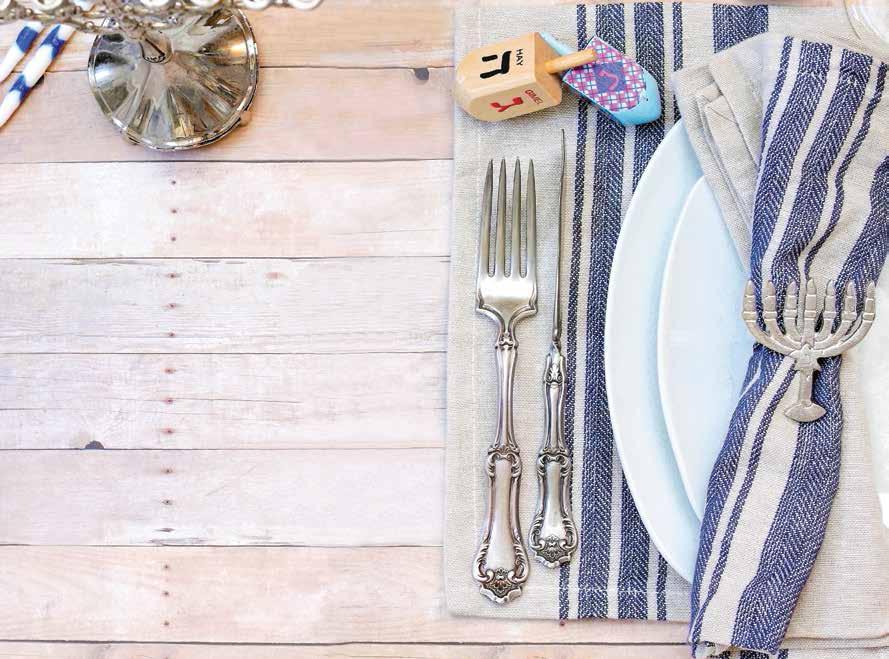
4 minute read
Easy At-Home Latkes
from Holiday Life 2022
By Allison Collins
Latkes are the food most associated with Hanukkah, and not just because they’re delicious.
Advertisement
While many sources connect the crispy potato pancakes and the oil in which they’re fried to the miracle of oil lasting for eight days and nights, others suggest a different history. According to reformjudaism.org, the “real history of latkes” begins in the late 18th century.
“Although potatoes were introduced to Europe in the 16th century,” it notes, “it took close to 200 years before the edible tuber made its way from animal fodder to prison food and then to sustenance for the masses, especially the poor.
“The real reason for latkes is explained by the traditional activity of slaughtering geese in early December,” the site continues. “For three months before slaughter, geese were slowly and methodically fed at increasing intervals and quantities to fatten them to excess. Goose feathers and down were used for warmth, the meat was preserved as a confit for winter consumption and goose fat was rendered to provide cooking oil for most of the year. Even a poor person could find a potato in the field, an onion in the cellar and some of the precious, newly rendered goose fat to create the Hanukkah culinary story of neis gadol hayah sham, ‘a great miracle happened here.’”
1 2 3 4
1. Latkes use simple, inexpensive staples to make a delicious holiday side. Peel large, Russet potatoes for latkes. 2. A food processor with shredding attachment is a great way to save time (and your arms) when preparing the latke batter. 3. After removing as much moisture as possible, dump shredded onion and potatoes into a large bowl. Add egg and seasonings to potato mixture. 4. Hands work best to mix the latke batter. Photos by Allison Collins
Kosher.com states, “We eat latkes … on Chanukah … because the holiday is about the small jar of oil miraculously lasting for eight days and, therefore, frying foods in oil commemorates that miracle.” But it, too, acknowledges, “there’s more to it than that.”
The site explains: “Chanukah celebrates the victory of the Jewish forces, led by the Chashmonaim (AKA the Maccabees), against their Syrian-Greek oppressors. The Jews recaptured the Temple and were able to rededicate the altar, giving the holiday its name (‘Chanukah’ meaning ‘dedication’). The menorah … was relit with a single cruse of ritually pure oil, enough for just one day, which miraculously lasted eight days.”
Further derivations of the Hanukkah story credit the victory of Judith, or Yehudit, with slaying the general Holofernes after plying him with drink and cheese, leading to the lesser-known holiday custom of eating fried cheese pancakes.
Despite a complex and varied history (what religious tradition isn’t?) these latkes are easy to make, elevating simple, staple ingredients to something special.

Ingredients:
3 large Russett potatoes, washed, peeled and shredded 1 white onion, peeled shredded 1 egg 2 tbsp. matzo meal or breadcrumbs 1 tsp. salt Canola or vegetable oil for frying Apple sauce and/or sour cream for serving Chives for garnish (optional) Yield: Roughly 12 latkes
Directions:
Wash and peel potatoes.
Once peeled, shred the potatoes using either a box grater or shredder attachment on a food processor.
With a cheesecloth, heavy-duty paper towels or a clean cloth towel, squeeze moisture from the shredded potatoes. (Squeeze hard!) Set aside in a large bowl.
Shred the onion and add to shredded potatoes.
Into the potatoes and onion, add egg, matzo meal or breadcrumbs and salt. Mix well.
Add oil to a heavy-bottomed skillet and heat on medium-high.
When oil is hot, scoop latke mixture with a ¼-cup measure and invert onto a spatula. Flatten with fingers and slide the patty into the oil. Repeat until the skillet is full but not crowded. Flip latkes when underside is crisp and golden brown, roughly five minutes per side.
Place cooked latkes on a paper towel-lined plate, sprinkle with salt and, if working in batches, set aside in a warm oven. Repeat process until all latke batter is cooked.
Serve latkes with sour cream or apple sauce (or, if you’re like me, both), and garnish with chives.
Leftover latkes (if there is such a thing) can be refrigerated in an air-tight container for up to five days. f
Tips: I found my hands worked best to mix the shredded potatoes and other ingredients. You can gauge the readiness of your oil by placing the stem of a wooden spoon in the oil. If bubbles swarm the spoon stem, it’s ready. I strongly recommend using a cast-iron skillet for these. They crisp up better and there’s never any sticking. I know purists will say a box grater is the only way to shred potatoes for latkes, but the shredder attachment on my food processor worked beautifully and saved not only time, but my arms. I also used it for shredding the onion.






